
|
 Home Home
 Projects Projects
 Experiments Experiments
 Circuits Circuits
 Theory Theory
 BLOG BLOG
 PIC Tutorials PIC Tutorials
 Time for Science Time for Science
|
| ||
|
25 March 2009 Author: Giorgos Lazaridis The SCRHistory Those devices as well as the thyristors, are based on the work of Bell laboratories. The leader of the research was John Moll. His goal was to make a replacement of the solid state relay with no moving or any other mechanical parts, that was finally achieved during 1954. The first series of SCRs where designed, created and characterized just two years later, and by then they had only two leads. That year the SCR took it's final outlook with 3 leads. Silicon Control Rectifiers was finally commercializes by General Electric. The champion of SCRs is said to be Bill Gutzwiller. He start working by General Electric in January 1955 in an engineering role at the rectifier manufacturing site at Clyde where Ray York was site director. Due to the prior work of Bell laboratories, General Electric did not patent the SCRs as there was no invention or record as far as the legal matters are concerned. SCR Symbols and equivalents The electronic circuit symbols of the Silicon Controlled Rectifier are as follows: 
The equivalent of a Silicon Controlled Rectifier is actually a set of two transistors, one NPN and one PNP connected back to back: 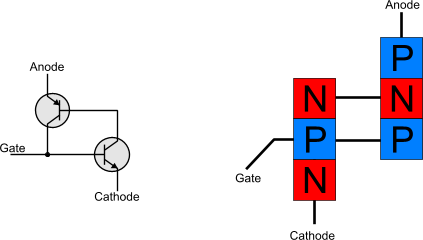
This transistor set will perform the Silicon Controlled Rectifier that is actually a PNPN contact as follows: 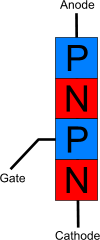
How SCR work The SCR's basic function is to replace the relay switches with a non-mechanical part. Modern SCRs are capable to handle loads with voltage ratings of up to 7500 volts, and with current ratings up to 3000 amperes RMS amperes per device. Special SRCs could manage loads even over 50 kA in single-pulse operation. Due to the lack of mechanical moving parts, an SCR has a much longer lifetime than a relay. Moreover, it can turn on and off a load in speeds that could reach the 25.000 times per second, when a small relay could cycle no faster than 100 time per minute. An SCR is made up with four layers of semiconductor material arranged in the order P-N-P-N. Consider an SCR as a transistor pair, one NPN and one PNP, connected back to back. The Anode 'A' is attached to the upper P-layer and the Cathode 'C' is connected to the lower N-layer. There is another lead called Gate 'G', that is connected to the mid P-layer. During the operation of an SRC, the collector of Q2 drives the base of Q1, while the collector of Q1 feeds back to the base of Q2. The gain of this positive feedback is the product of the Beta gain of the first transistor multiplied by the Beta gain of the second transistor. When this product is less than one, the circuit is considered to be stable, otherwise the circuit is regenerative. A smll negative current applied to the Gate, will bias the NPN transistor into cutoff and will drop the gain of the feedback under 1. By that time, only a slight current can exist between the Anode and the Cathide from the very small cutoff collector current of the transistors. Therefore, the impedance between the anode and cathode is very high. When a positive current is applied to the Gate lead, the NPN transistor is sent into a conductive state causing the collector current to rise. The gain of the feedback will increase by the increment of the gain of the NPN transistor and will become regenerative. The collector current on both transistors will be increased to a value limited only by the external circuitry. Both transistors are driven into saturation and the impedance between Anode and Cathode becomes very low. If the Anode-Cathode is forward biased, the current will flow within the SCR and will only find a very slight resistance. If this happens, then the positive current on the Gate is no longer needed in order to keep the Anode-Cathode conductive, as the transistors will perform a self-regenerative action. The SCR will remain in this condition as long as the Anode-Cathode voltage becomes zero or reverse biased. The following curve is the characteristic curve of an SCR with no current or negative current on the Gate. If the Anode-Cathode voltage difference is greater than the Breakover Voltage, the SCR goes into a state that this contact becomes highly conductive, the current increases rapidly and reaches greater values than an SCR can usually handle (due to the high voltage already applied) and thus, the SCR is destroyed. The same effect is occurred when the voltage difference between the Anode and the Cathode becomes reverse and higher than the Reverse Breakover Voltage. 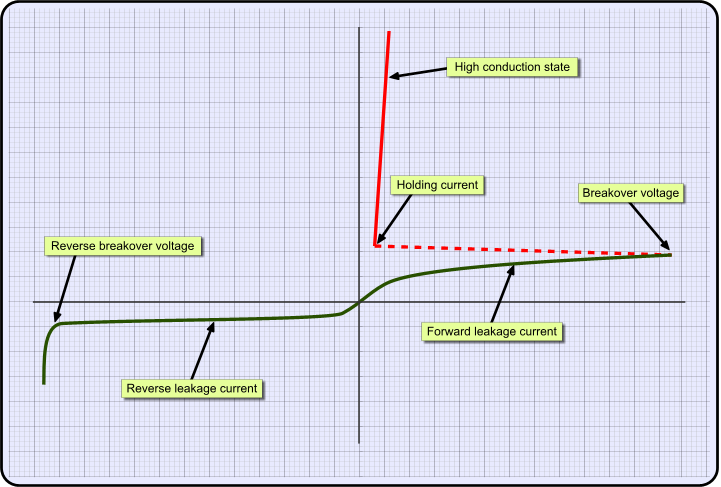
The next image shows the characteristic curve of an SCR the time that some positive current flows from within the Gate lead. The breakdown voltage is significantly reduced with the effect of a very slight current applied on the Gate. If by the same time voltage is applied between Anode and Cathode, current will flow from within this contact. Due to the fact that not very high voltage is needed any more, the current is controllable from the rest of the circuit and therefore it will not increase into values that may destroy the SRC. The SRC will remain conductive as far as the Anode-Cathode contact is held forward biased (positive voltage applied to Anode and negative to Cathode), with no respect to the Gate current. This means that even if there is no voltage applied to the Gate, the SCR will remain conductive. Still, if the SCR's Anode-Cathode is reverse biased and the voltage is higher than the reverse breakover voltage, the SCR will be destroyed. 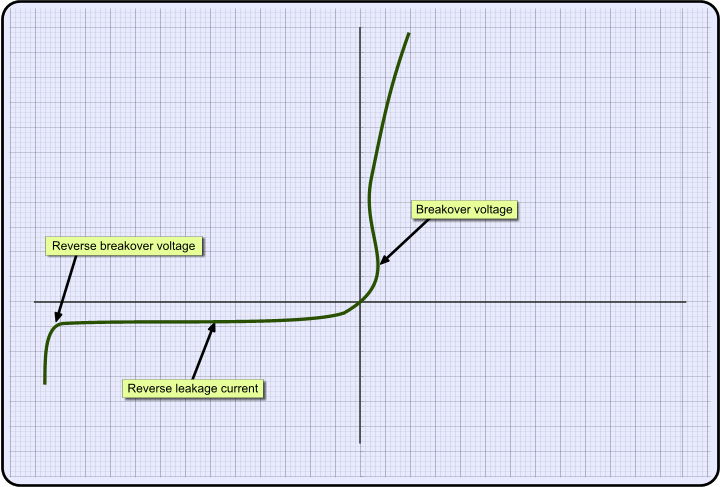
SCR gate triggering A very simple triggering circuit can be seen below: 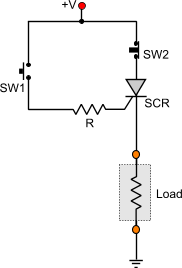
The circuit has two push buttons. SW1 is a normal open (NO) pushbutton, while SW2 is a normal close (NC) pushbutton. If SW1 1 is pushed, a current will flow within the protective resistor R right in the Gate of the SRC. That is enough to trigger the SRC. To calculate the protective resistance, you have to know the gate voltage VG and the gate current IG needed so that the gate pulse will turn the SRC conductive. If you know that, then you can apply to the following formula: R = (V - VG) / IG If for example a thyristor has VG = 3V and IG=150mA and the supply voltage of the circuit is 12V, R = ( 12 - 3 ) / 0.15 => R = 60 Ohms. As long as the SW2 is concerned, it's purpose on the circuit is to turn the SCR into no-conductive state. When SW2 is pushed, the Anode will have no more positive voltage and therefore the SRC will act as a circuit break. The above circuit is a very simple version of a triggering circuit. It could be much more complicated according to the needs of the application. The most commons applications for an SCR is the power delivery control. Inverters, dimmers, switching power supplies and many more power-delivery and control equipment uses the SCR as the final stage to deliver controllable low or high power. Relative pages Comments
|
|
 Contact Contact
 Forum Forum
 Projects Projects
 Experiments Experiments
 Circuits Circuits
 Theory Theory
 BLOG BLOG
 PIC Tutorials PIC Tutorials
 Time for Science Time for Science
 RSS RSS
Site design: Giorgos Lazaridis © Copyright 2008 Please read the Terms of services and the Privacy policy |